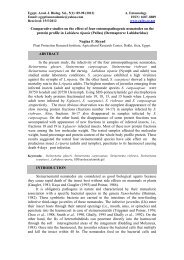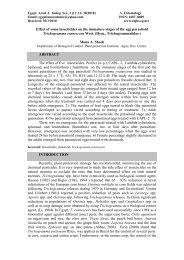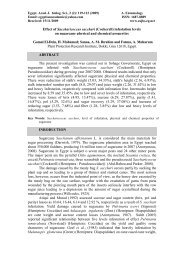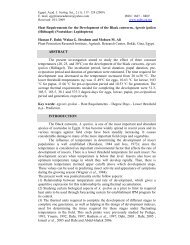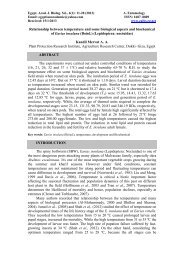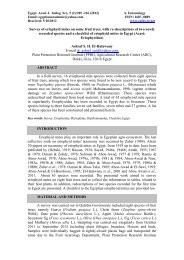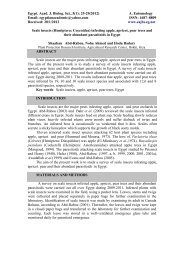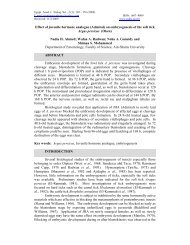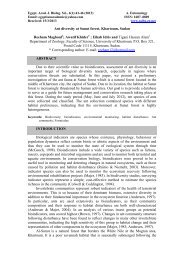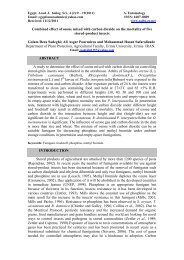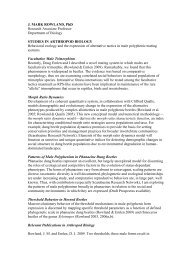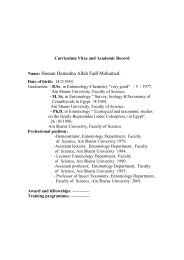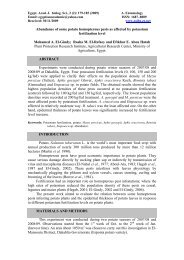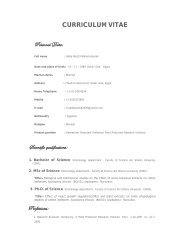Comparison of RAPD and PCR-RFLP markers for classification and ...
Comparison of RAPD and PCR-RFLP markers for classification and ...
Comparison of RAPD and PCR-RFLP markers for classification and ...
Create successful ePaper yourself
Turn your PDF publications into a flip-book with our unique Google optimized e-Paper software.
<strong>Comparison</strong> <strong>of</strong> <strong>RAPD</strong> <strong>and</strong> <strong>PCR</strong>-<strong>RFLP</strong> <strong>markers</strong> <strong>for</strong> <strong>classification</strong> <strong>and</strong> taxonomic studies 193<br />
In this study, <strong>RAPD</strong> analysis proved to be as in<strong>for</strong>mative as <strong>PCR</strong>-<strong>RFLP</strong><br />
analysis. The frequency <strong>of</strong> diagnostic primers observed in this study is quite high in<br />
comparison to studies <strong>of</strong> closely related species. There were no accepted methods <strong>for</strong><br />
estimating genetic divergence from <strong>RAPD</strong> data <strong>and</strong> this may be considerable<br />
technical difficulty. However, the genetic similarity suggested by <strong>RAPD</strong> survey <strong>of</strong> C.<br />
maculatus <strong>and</strong> C. bicolor species is seemingly at odds with their extreme<br />
morphological dissimilarity. While <strong>RAPD</strong> analysis is clearly an approach <strong>of</strong> merit <strong>for</strong><br />
such studies, some characteristics <strong>of</strong> <strong>RAPD</strong> reactions were encountered. First, <strong>RAPD</strong><br />
b<strong>and</strong> patterns must be empirically determined to be reproducible be<strong>for</strong>e their use as<br />
<strong>markers</strong> is justified. This could be made after repeated reactions to confirm the<br />
absence or presence <strong>of</strong> the b<strong>and</strong>. Second, preferential amplification during <strong>RAPD</strong><br />
reactions has little effect on the use <strong>of</strong> <strong>RAPD</strong> <strong>markers</strong> in diagnostic studies, but could<br />
be <strong>of</strong> serious importance in studies requiring independent <strong>markers</strong>, such as hybrid<br />
zone analysis, pedigree analysis or relatedness estimates based on b<strong>and</strong> sharing.<br />
Finally, the inference that b<strong>and</strong>s <strong>of</strong> similar size in different individuals are truly<br />
homologous should be made cautiously <strong>and</strong> rejected in cases <strong>of</strong> complex b<strong>and</strong>ing<br />
patterns or the b<strong>and</strong>s that differ in intensity or reproducibility. B<strong>and</strong> homology can<br />
only be definitely determined by further investigation, such as Southern blotting or<br />
sequencing. To avoid complicated interpretation, the primers used should have some<br />
characteristics, such as strong diagnostic b<strong>and</strong>s <strong>and</strong> simple patterns. Primers<br />
producing b<strong>and</strong>ing patterns that are in any way suspect should be passed over in<br />
favour <strong>of</strong> screening additional primers <strong>for</strong> <strong>markers</strong> with optimal characteristics.<br />
Conclusively, on the bases <strong>of</strong> ease, cost, technical labor, speed <strong>and</strong> amount <strong>of</strong><br />
DNA needed, the <strong>RAPD</strong> marker system is preferentially used in taxonomic <strong>and</strong><br />
<strong>classification</strong> studies. On the bases <strong>of</strong> degree <strong>of</strong> polymorphism, precision <strong>of</strong> genetic<br />
distance estimates <strong>and</strong> the statistical power <strong>of</strong> the test, no differences were observed<br />
between <strong>RAPD</strong> <strong>and</strong> <strong>PCR</strong>-<strong>RFLP</strong> tests.<br />
REFERENCES<br />
Alam, M. T.; Manoj K. D.; Ansari, M. A. <strong>and</strong> Sharma, Y. D. (2006): Molecular<br />
identification <strong>of</strong> Anopheles (Cellia) sundaicus from the Andaman <strong>and</strong> Nicobar<br />
isl<strong>and</strong>s <strong>of</strong> India. Acta Tropica. 97: 10–18.<br />
Aljanabi, S. M.; Marta, 1.; Loiácono, S.; Lourenço, R. T.; Borges M. <strong>and</strong> Tigano, M.<br />
S. (1998): <strong>RAPD</strong> analysis revealing polymorphism in egg parasitoids <strong>of</strong><br />
soybean stink bugs (Hemiptera: Pentatomidae). Soc. Entomol. Brasil. 27(3):<br />
413-417.<br />
Benchimol, L. L.; Souza, Jr. C.; Garcia, A. A.; Kono, P. M.; Mangolim, C. A.;<br />
Barbosa, A. M.; Coelho, A. S. <strong>and</strong> Souza, A. P. (2000): Genetic diversity in<br />
tropical maize inbred lines: Heterotic group assignment <strong>and</strong> hybrid<br />
per<strong>for</strong>mance determined by <strong>RFLP</strong> marker. Plant Breeding 119(6): 491-496.<br />
Black, W. C. (1993): <strong>PCR</strong> with arbitrary primers: approach with care. Insect Mol.<br />
Biol. 2: 1–6.<br />
Botstein, D.; White, K. L.; Skolnick, M. <strong>and</strong> Davis, R. W. (1980): Construction <strong>of</strong> a<br />
genetic linkage map in man using restriction fragment length polymorphisms.<br />
Am. J. Hum. Genet. 32: 314-33l .<br />
Chapini, E.; Soressi, L.; Fogher, C. <strong>and</strong> Zanirato, M. (1999): Genetic identity <strong>and</strong><br />
relationship between four Anagrus species (Hymenoptera: Mymaridae) using<br />
<strong>RAPD</strong> analysis. Eru. J. Entomol. 96: 393-400.



